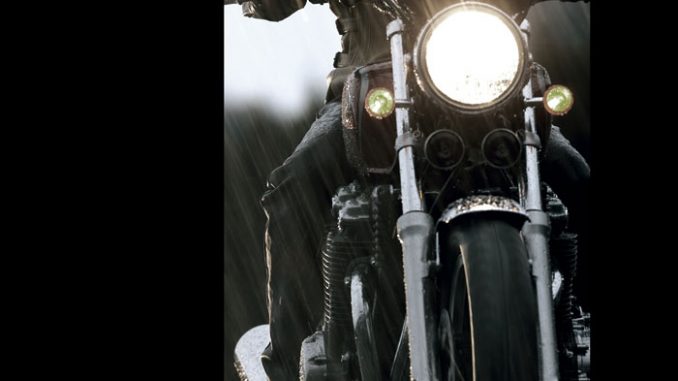
Back to 2012 Honda Motorcycle Model Review Page
Click photos to enlarge.
They make great desktop images.
– 2012 Honda CB1100 Naked
2012 Honda CB1100 Naked Review
The CB1100 pleases the eye and stirs the emotions like no other naked machine.
Powered by an air-cooled, 4-stroke, inline-4 DOHC engine, this gutsy naked model proudly bears the CB name symbolic of Honda motorcycles. ‘Big Hearted,’ was the development concept for this remarkable machine that was designed for three simple aims: easy riding, to be seen on and to be looked at.
Rather than high power, it pursues great riding quality and a muscular riding appearance. And because the big CB has the weight and compactness of a 1140cc, it offers superb maneuverability and is very rider-responsive.
With its air-cooled inline 4 engine, the CB1100 is a modern expression of traditional motorcycling ideals.
2012 Honda CB1100 Naked Key Features
The history of Honda’s motorcycles began 60 years ago, as did the history of Honda’s pursuit of ultimate motorcycle performance.
Striving to maximize both speed and rider comfort, Honda has taken on—and overcome—an extremely wide variety of challenges.
The steady evolution of Honda’s motorcycles over the decades would not have been possible without Honda’s distinctive approach to motorcycle design. For example, in pursuit of optimal engine performance, Honda advanced from air-cooled to liquid-cooled engine designs, eliminated the cooling fins once considered essential.
While enhancing engine performance, Honda sought also to increase handling stability. The rider has more forward-leaning posture on the bike for easier, more-fluid cornering. This and the addition of a cowl and fairings for enhanced aerodynamic performance make for a stylish design.
While Honda’s bikes continuously attained new levels of performance, their designs also became more refined and stylish. In both performance and styling, Honda has always been ahead of the times, taking on tough challenges to produce such ground-breaking models as the NR750, the CBR900RR and the RC211V. These are just a few of the ground-breaking models that have exemplified Honda innovation over the years.
2012 Honda CB1100 Naked Features and Benefits
DESIGNER CHAT
The CB1100 offers a two-wheeled experience that is simply sublime thanks to its smooth power delivered from an 1140cc inline four-cylinder engine with dual overhead cams and an 8500 rpm rev range
Visually, the CB1100 is classic perfection. Its impressive looks incorporate the large, clean engine that lends the rider into a purposeful, forward-biased stance, perfectly accentuated with the crisp, striking lines of the fuel tank
Fuel injected 1140cc inline four-cylinder engine with dual overhead cams
41mm standard fork front suspension and preload-adjustable Showa dampers at the rear
Low, comfortable seat height of 775 mm
Unique vintage look with all the mod cons of a new bike
IT JUST HAD TO BE AN AIR COOLED ENGINE
Instant acceleration has its appeal, as does modern styling that conveys the swiftness of the bike. But there’s a lot more to the path of motorcycle evolution.
I found myself thinking along these lines for the first time when I returned to Japan after several years in Europe. It was also at this time that I grabbed a pencil and quickly sketched the drawing shown on this page.
Tires. Engine. Frame. Tank. Seat. I thought about how to craft all the necessary elements beautifully and combine them in a perfect whole.
A simple and efficient double cradle frame embraces the air-cooled inline-4 engine which secured Honda’s status as the 4-cylinder pioneer and the creator of the CB750 Four and the CB400 Four.
Building on this proud tradition, the approach to the new bike strives for beauty, craftsmanship, ease. In other words, I wanted to create a beautiful motorcycle with artisan-level handiwork that’s also approachable and easy to ride.
“Why are you giving that new engine air-cooling when you know its performance won’t be as good? You had better have a pretty convincing explanation!”
That’s the kind of thing people said when we began the development process. And I could understand that thinking. Going with an air-cooled engine was bound to seem “retro” to people at Honda, which had long favored liquid-cooled systems in the pursuit of maximal performance.
When asked to explain my choice, I could only say: “My only reason is that a lot of customers like air-cooled engines.”
I like the metallic sound the engine makes as it cools… A motorcycle’s engine should have oil in it, not water… Just looking at the cooling fins inspires me… There is something about an air-cooled engine—a feeling you simply can’t get from the liquid-cooled engine in a high-performance bike. To me, a bike rider and a bike fan, a future without air-cooled engines just didn’t seem right. And I was certain I wasn’t the only one who felt this way!
Based on my sketch, this “bike that defies logic and just demands to be ridden” became a reality: We displayed the CB Four concept model at the Tokyo Motor Show in 1999, and I was extremely thankful for the enthusiastic response it received there. In 2007, aiming to create a bike that fulfilled fans’ vision even more fully, we displayed a new concept model at the Tokyo Motor Show, the CB1100F. Eventually, this concept model became the production model known as the CB1100.
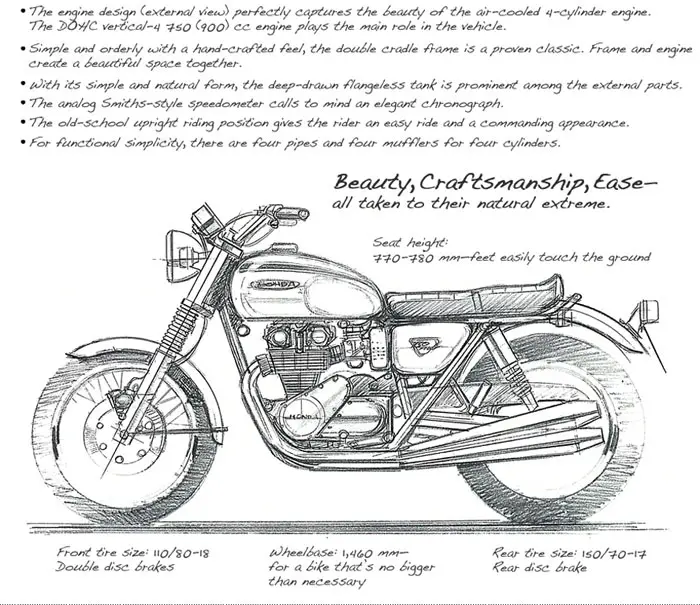
This is the sketch the designer drew after his return from Europe. Based on it, the CB Four concept model was born.
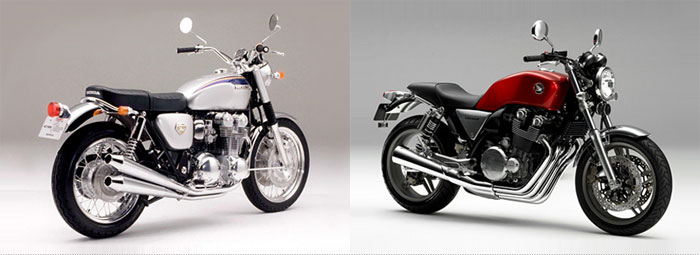
Left – Displayed at the Tokyo Motor Show in 1999, the CB Four concept model celebrated the 30th anniversary of the inline-4 CB bikes. With its uniquely emotional exterior styling and form-follows-function aesthetic, this was a naked motorcycle for the serious rider. Right – The CB1100F concept model, displayed at the Tokyo Motor Show in 2007. Following in the footsteps of the 1999 CB Four concept model, this model also honored the air-cooled 4-cylinder CB bikes. With 17-inch tires in the front and rear, this bike was quite sporty as compared to the CB1100.
OUR MISSION: DESIGN – NOT STYLING
In taking on the design of the CB1100, the team and I agreed that our mission was design—not styling. These words tend to get confused with one another, but at base they mean two totally different things. “Styling” refers to establishing the look the vehicle needs to have, adding motifs, and otherwise enhancing its appearance. On the other hand, the elements of “design” are mostly to be found in the actual drawings of the machine, serving as the true origins of the form of the vehicle.
Unlike an automobile, a motorcycle is not covered with a body, so there is no clear division between exterior and interior. Rather, the visible mechanical parts serve as the exterior decoration. For these reason, we needed to keep our focus on the pure design elements, making each mechanical part as beautiful in form as possible. To create parts that were both beautiful and functional, we utilized the characteristics of many different materials, including metal, plastic, leather and rubber. This approach is what design is all about and lets designers show what they can really do.
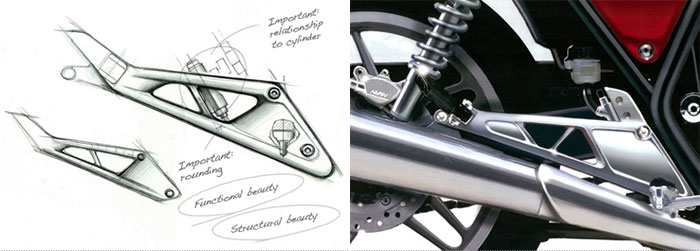
The goal is to design each of the parts that form the motorcycle so that they are both functional and beautiful.
Even the step holder reflects the designer’s meticulous attention to detail.
AIMING FOR BEAUTY AND FUN THAT TRANSCEND THE NUMBERS
What plays the main role in the design of the CB1100? Definitely the engine.
The cooling fins that cover the surface of the CB1100’s air-cooled engine are quite different from the fins used to decorate a liquid-cooled engine, or the ribs used to strengthen one. Instead, they play the crucial role of increasing the surface area of the engine, thereby helping to disperse heat. At the same time, they give the naked engine a glorious appearance sure to draw admiring glances once the rider dismounts.
Beauty is a subjective thing that can’t be expressed in numbers or explained with logic. While valuing the way that air passed over the fins, so that they could perform their crucial function of carrying heat away from the engine, we also greatly valued—as fans of bikes and guys who love machinery—the excitement that the appearance of the fins could produce, and we shaped them with appropriate care.
Fulfilling the requirements of beauty and function resulted in cooling fins that were just 2 mm thick—the thinnest of any model in the Honda lineup. Commercially producing such fins is difficult, and at first the factory told us it was impossible. But we developed a new production process to make the fins possible, and they became a part of the bike of which we are extremely proud.
.
The two camshafts—which are often said to look like eyes—can’t be too close together, or the engine won’t look cool. Putting them just the right distance apart may not help maximize performance, but it helps provide the grand proportions befitting a large-displacement engine.
At the same time, the required performance numbers will influence such dimensions as engine height, engine width, valve angles and so on, and all these figures will tend to determine by themselves the engine size and shape.
The CB1100 engine was no different, and an engineer said to me at the beginning of the process, “What level of displacement did you have in mind?”
Uh oh—he asked! I thought.
The amazing thing about Honda’s engineers is that, once they establish an objective, they never quit until they fulfill it. Had the objective been horsepower, there would have been no problem whatsoever. In striving to bring true joy to CB1100 customers, there were things more important to us than horsepower.
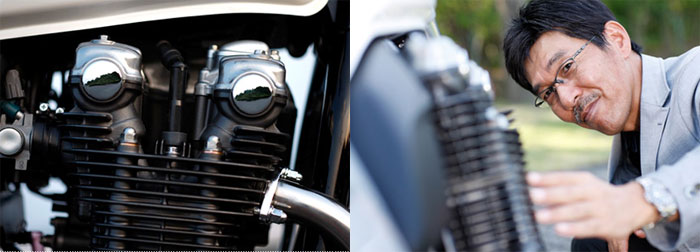
Not too far apart, not too close: the design team paid special attention to the positioning of the two camshafts. Freed from the necessity of maximizing output, they were able to establish the grand proportions that befit a large-displacement bike.
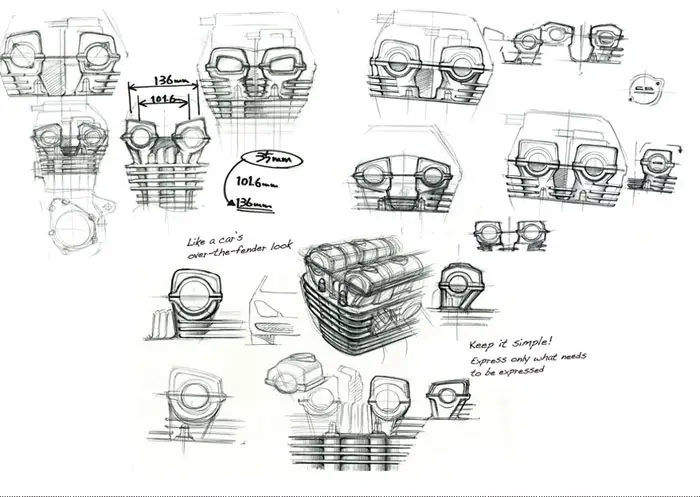
This hand-drawn sketch of possible engine shapes hints at the process of trial and error that was required to create a truly beautiful engine.
For this reason, I responded thus to the engineer’s question: “Let’s decide after we ride it. If it’s fun to ride, then that’s what we’ll need.” Since, like beauty, fun is a concept that cannot be numerically expressed, the associates who were responsible for engine design and testing had quite a tough time fulfilling this particular requirement.
Yet, freed from the necessity of maximizing output, the designers came together and created an air-cooled engine offering not a superficial, decorative appearance but instead true beauty based on the essence of the molded form. I believe that this was a huge accomplishment.
.
The fuel tank is another part that, while functional, has as big an impact as the engine on the external appearance of the motorcycle. In most super sport bikes like the CBR series, the tank is molded so that its front points downward for a dynamic appearance, and the tank often features deeply curved surfaces for a 3D effect. On the CBR1100, however, the fuel tank extends horizontally in relation to the engine and is natural in every detail, including the indentations that help give the knees a comfortable position. What is also extremely important is that, when seated, the rider is able to see the first and fourth cylinder heads of the main attraction, the engine.
.
The form of the fuel tank comes down to the molding process, and from the beginning we decided against using any graphics other than pinstripes to bring out the shape. As we did with the RC212V, CBR1000RR and VFR1200F, we put the Honda wing logo on a badge. It’s a small badge, but we considered a wide range of positions with millimeter-level precision, searching until we found the spot that perfectly complemented the side view of the bike.
I kept telling the team that we didn’t need to give the fuel tank any particular individuality, but I think we ended up with a shape that, while simple, makes a lasting impression of true Honda style.
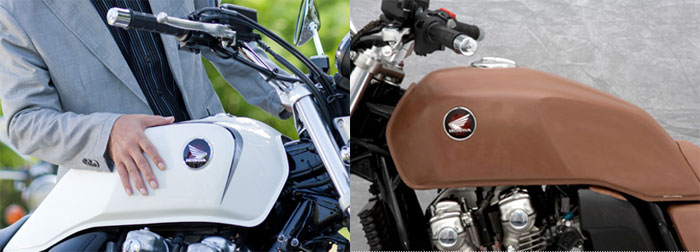
Meticulously designed, the fuel tank badge plays almost as important a role as the engine in the overall look. The designers searched with millimeter-level precision until they found the perfect position for the badge.
BEAUTIFUL FUNCTIONAL PARTS IN A BEAUTIFUL SILHOUETTE
While designing the functional parts of the CB1100 for maximal beauty, we kept one other thing in mind at all times: the silhouette.
What is the “silhouette”? It’s the essential form of the bike that’s still there when you take away the engine, fuel tank, seat and all the other details.
What makes for a good motorcycle silhouette depends on the purpose the particular model is being created to fulfill. The silhouette of a super sport bike appears to be lower in front—like a crouching animal, ready to pounce. On the other hand, the silhouette of a cruiser has a low center of gravity and an easygoing feel overall.
The silhouette of the CB1100 can best be described by the word “dignified.” It’s not forced or strained, and it’s not loose or lax, either. Rather, it simply extends its back straight forward with an upright posture. The shape and dimensions of the frame create this silhouette, which is then complemented by the proper placement of the beautifully designed functional parts, including the engine, fuel tank and seat. In this way, we created the beautiful and universally appealing design of the CB1100.
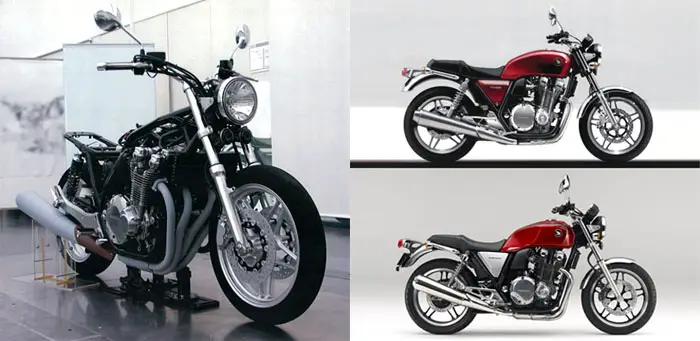
Left – Without the fuel tank and seat, it is easy to see the silhouette of the CB1100. Although many types of bikes have become more forward-leaning over time, the CB1100 features a dignified upright posture. Right – With just a few small changes, the silhouette can make a vastly different impression. An initial sketch version went all the way to the clay model stage. Finding it to be too tense, the designers went back to the drawing board. The difference between it and the final CB1100 is striking.
BUILT ON HONDA’S MOTORCYCLE ORIGINS. POLISHED TO PERFECTION
Although it offers a sporty ride, the CB1100 is not a sport bike. It’s a great motorcycle to take on a tour, but it’s not a tourer or a cruiser. Despite how good it feels to zip around town on the CB1100, it’s not a street bike, either. Focused only on the elements that make a motorcycle a motorcycle, we built the CB1100 on the origins of Honda’s motorcycles and polished it to perfection. The result is an archetypal “cool bike.”
It’s a bike that requires no big “Let’s ride!” occasion or attitude. Rather, you can simply think, “The weather is nice—where shall I go?” and take your CB1100 for an easygoing spin. It’s a bike that will soon become a trusted friend and ally.
Honda motorcycle designers will continue the search for new possibilities in performance and design. At the same time, by building our bikes on Honda’s motorcycle origins and polishing them to perfection, we’ll seek to offer true joy to bike fans and riders everywhere.
Going forward, expect great things from Honda!
2012 Honda CB1100 Naked – Australian Specifications
Australia MSRP Price – NA USD
ENGINE
TYPE 1140cc air-cooled 4-stroke 16-valve DOHC inline-4
BORE AND STROKE 73.5 x 67.2mm
COMPRESSION RATIO 9.5 : 1
STARTER Electric
CARBURETION PGM-FI, one 36mm throttle body
IGNITION Fully transtorised, computer controlled digital transistorised with electric advance
TRANSMISSION 5-speed
FRAME
DIMENSIONS (LxWxH) 2,195 x 835 x 1,130mm
WHEEL BASE 1,490mm
SEAT HEIGHT 775mm
GROUND CLEARANCE 125mm
FUEL CAPACITY 14.6 litres
KERB WEIGHT 248kg
TYRES
FRONT 110/80 18-inch
REAR 140/70 18-inch
SUSPENSION
FRONT 41mm telescopic fork, 107mm stroke
REAR Twin showa shock absorber with spring pre-load adjustment
BRAKES
FRONT Twin 296mm x 4.5mm floating discs with 4 piston Nissin callipers
REAR 256mm x 6mm disc with single piston Nissin calliper
WARRANTY
WARRANTY PERIOD 24 months
Note Specifications subject to change without notice.
2012 Honda CB1100 Naked – Japanese Specifications
Japan MSRP Price (JPY) – ¥920,000 Black Style; ¥990,000 Black Style ABS; ¥950,000 CB1100; ¥1,020,000 CB1100ABS
ABS specifications in brackets
Car model name,
Honda · EBL-SC65
Length (mm)
2,205
Overall width (mm)
835
Height (mm)
7.50
Wheelbase (mm)
1,490
Minimum ground clearance (mm) 125
Seat height (mm)
765
Vehicle weight (kg)
243 [247]
Seating capacity (persons)
Two
Fuel consumption rate (km / L) * 1 (Fixed area traveling test value 60km / h) 27.0
Minimum turning radius (m)
2.7
Engine Model
SC65E Engine Type
DOHC4 valve inline 4-cylinder 4-stroke air-cooled
Total displacement (cm 3)
1,140
Inner diameter × stroke (mm) 73.5 × 67.2
Compression ratio
9.5
Maximum output (kW [PS] / rpm) * 2 65 [88] / 7,500
Maximum torque (N · m [kgf · m] / rpm) * 2 92 [9.4] / 5,000
Fuel supply system format
Electronic <electronically controlled fuel injection system (PGM-FI)>
Starting method
Self
Ignition device format
Full-transistor battery ignition
Lubricating method
Combination formula splash pumping
Fuel tank capacity (L)
14
Clutch type
Wet multi-plate coil spring ceremony
Transmission format
Constant mesh 5-speed return
1-speed gear ratio
3.166
2-speed gear ratio
2.062
3-speed gear ratio
1.545
4-speed gear ratio
1.250
5-speed gear ratio
1.111 Reduction ratio (primary / secondary) 1.652/2.166
Caster angle (degrees)
27 ° 00 ‘
The amount of trail (mm)
114
Tire (front)
110/80R18M/C 58V
Tire (rear)
140/70R18M/C 67V
Brake type (front)
Hydraulic double disc
Brake type (rear)
Hydraulic disc
Suspension system (front)
Telescopic
Suspension system (rear)
Swing arm
Frame format
Double cradle
Remarks
– numeric type approval application form by the Road Vehicles Act (Seat height measurements Honda) Honda Motor Co., Ltd. / manufacturer
* 1. Fuel consumption rate is the value of the test under the conditions stipulated. Different customer’s environment (weather, traffic jams, etc.) depending on the conditions and method of operation, the vehicle state (with specifications), maintenance, etc.
* 2. The maximum torque is the maximum output and net. The term “internet” is measured under the same conditions substantially the state in which the engine is mounted on a vehicle.
2012 Honda CB1000RA – American Specifications
USD MSRP Price – NA USD
Not Available. Honda, bring this bike to the USA.
2012 Honda CB1000RA – Canadian Specifications
Canada MSRP Price – NA CDN
Not Available. Honda, bring this bike to Canada.
All specifications are provisional and subject to change without notice.


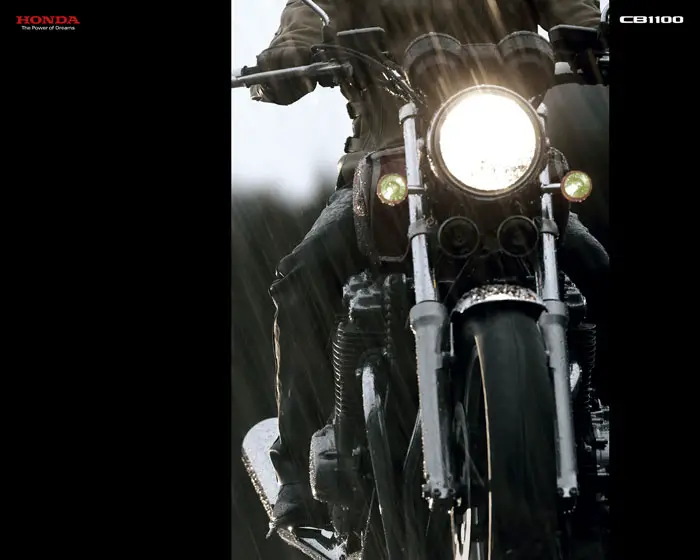
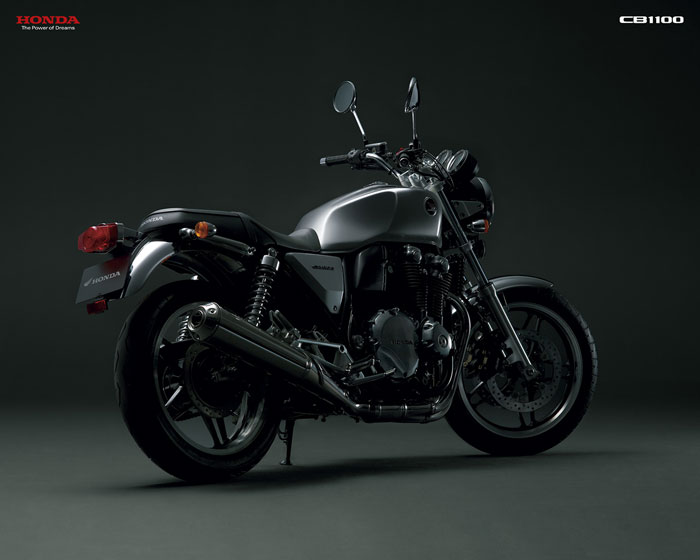
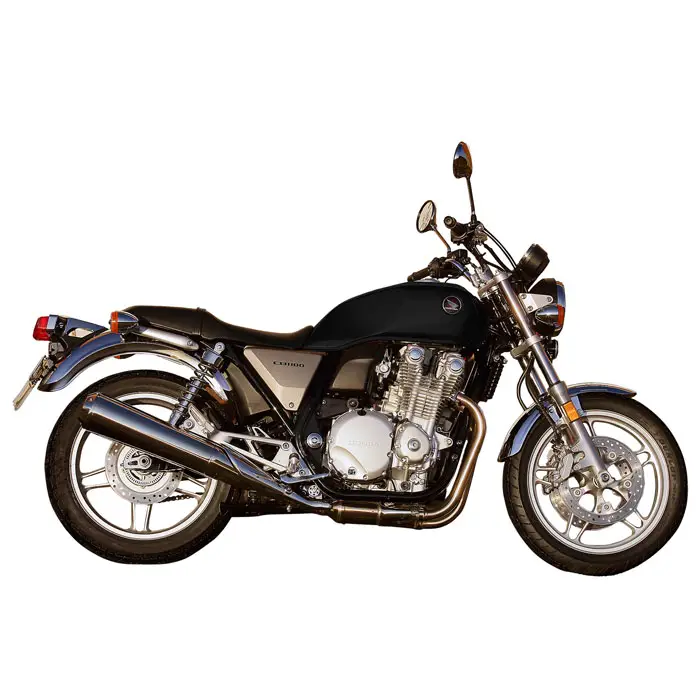
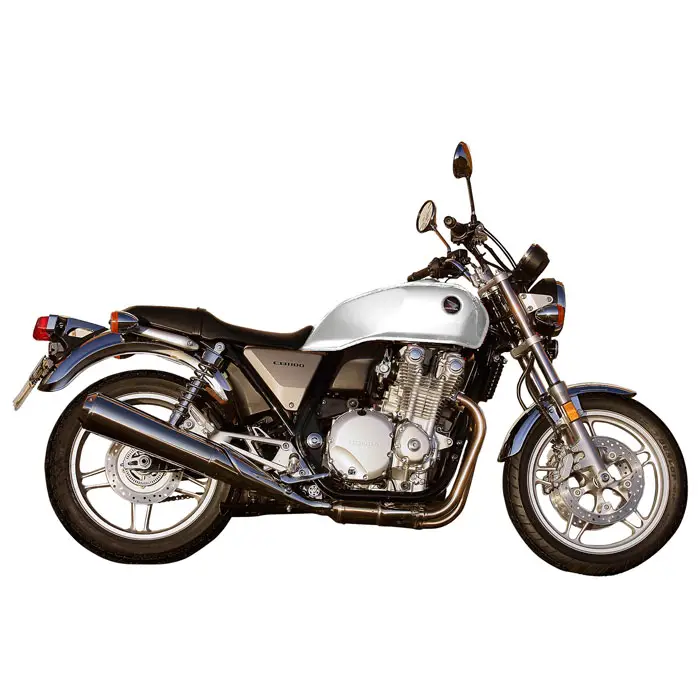
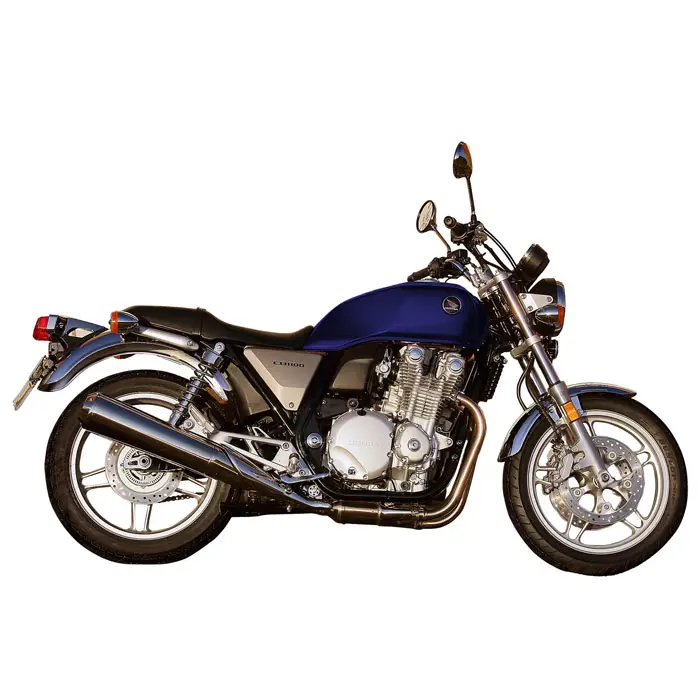

Be the first to comment